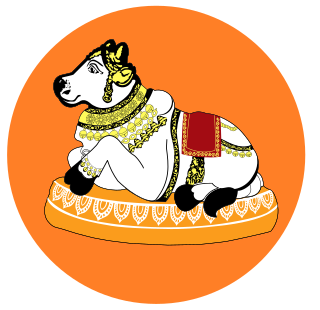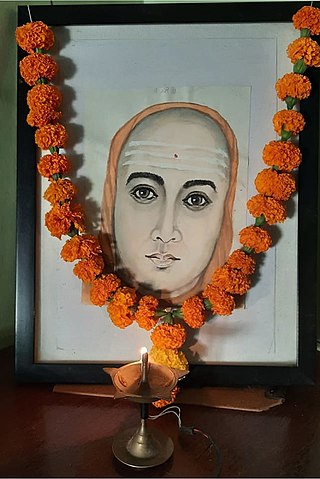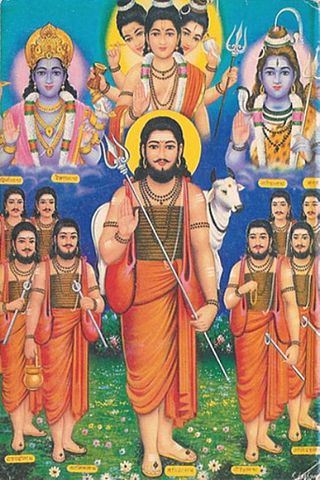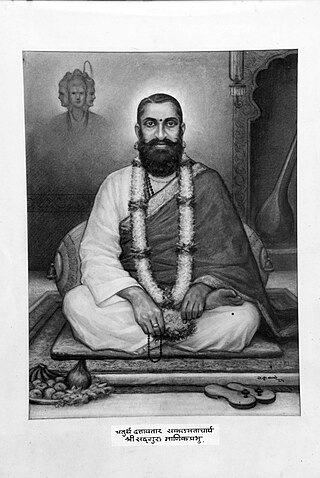
Dattatreya, Dattā or Dattaguru, is a paradigmatic Sannyasi (monk) and one of the lords of yoga, venerated as a Hindu god. He is considered to be an avatar and combined form of the three Hindu gods Brahma, Vishnu, and Shiva, who are also collectively known as the Trimurti, and as the manifestation of Parabrahma, the supreme being, in texts such as the Bhagavata Purana, the Markandeya Purana, and the Brahmanda Purana, though stories about his birth and origin vary from text to text. Several Upanishads are dedicated to him, as are texts of the Vedanta-Yoga tradition in Hinduism. One of the most important texts of Hinduism, namely Avadhuta Gita is attributed to Dattatreya. Over time, Dattatreya has inspired many monastic movements in Shaivism, Vaishnavism, and Shaktism, particularly in the Deccan region of India, Maharashtra, Gujarat, Madhya Pradesh, Rajasthan and Himalayan regions where Shaivism is prevalent. His pursuit of simple life, kindness to all, sharing of his knowledge and the meaning of life during his travels is reverentially mentioned in the poems by Tukaram, a saint-poet of the Bhakti movement.
Mahanubhava refers to Krishnaite Hindu denomination in India that was founded by Sarvadnya Shri Chakradhar Swami, an ascetic and philosopher who is considered as a reincarnation of Krishna by his devotees Some sources list the founders as Chakrapani and Govinda Prabhu with Chakradhara as the first "apostle" and propagator of Mahanubhava Pantha. Mahanubhava Sampradaya was formally formed in modern-day Varhad region of Maharashtra in 1267 CE. It has different names such as Jai Krishni Pantha in Punjab and Achyuta Pantha in Gujarat. Mahanubhava Pantha was also known as Paramarga by its followers in 13th century. Nagadevacharya, also known as Bhatobas, became the head of Sampradaya after Chakradhara.

Natha, also called Nath, are a Shaiva sub-tradition within Hinduism in India and Nepal. A medieval movement, it combined ideas from Buddhism, Shaivism and Yoga traditions of the Indian subcontinent. The Naths have been a confederation of devotees who consider Shiva as their first lord or guru, with varying lists of additional gurus. Of these, the 9th or 10th century Matsyendranatha and the ideas and organization mainly developed by Gorakhnath are particularly important. Gorakhnath is considered the originator of the Nath Panth.

Sripada Srivallabha is an Indian guru of the Dattatreya Sampradaya (Lineage) who is regarded as an incarnation of Lord Dattatreya. He is considered as one of the first complete Avatars (incarnations) of the deity Dattatreya in Kali Yuga. Of note, Narasimha Saraswati, Manik Prabhu, Swami Samarth, Sai Baba of Shirdi, are believed to be other incarnations of Lord Dattatreya that followed Sripada Srivallabha.
The Shri Guru Charitra is a book based on the life of Shri Nrusimha Saraswati, written by the 15th-16th century poet Shri Saraswati Gangadhar.

Shree Narasimha Saraswati Swami or Shree Nrusimha Saraswati Swami was an Indian guru of Dattatreya tradition(sampradaya). According to the Shri GuruCharitra, he is the second avatar of Dattatreya in Kali Yuga after Sripada Sri Vallabha.

Shri Swami Samarth Maharaj also known as Swami of Akkalkot was an Indian Hindu saint of the Dattatreya Tradition. He lived during the nineteenth century from 1858 to 1878 and is a known spiritual figure in various Indian states including Karnataka and Maharashtra. Swami Samarth traveled all across the Indian subcontinent and eventually set his abode at Akkalkot, a village in present-day Maharashtra. He is thought to have arrived at Akkalkot on a Wednesday, during either September or October in 1856. He resided at Akkalkot for close to 22 years.

Vasudevanand Saraswati, also known as Tembe Swami, is a Hindu saint who is regarded as an incarnation of Dattatreya.

Shri Samartha Sadaguru Ganapatrao Maharaj Kannur (1909–2004) was an Indian guru in the Inchegeri Sampradaya.
Nrusinhawadi commonly known as Narsobawadi or Narsobachi Wadi is a small town in Shirol Tahasil in Kolhapur district, Maharashtra. Narsobawadi gets its name from the presence of 'Shri Nrusinha Saraswati', the Purna Avatar of Lord Dattatreya.
Chakradhar(a) (Marathi: चक्रधर), also known as (Sarvajna Shri) Chakradhar(a) Swami or Kunwar Haripaladeva was an Indian Hindu saint and philosopher, who was the founder of Mahanubhava sect of Krishnaism. Chakradhar advocated worship of the god Krishna and preached a distinct philosophy based on Bhakti. He was an exponent of the Dvaita philosophy within Hinduism.

Datta Jayanti, also known as Dattatreya Jayanti, is a Hindu festival, commemorating the birth of the Hindu deity Dattatreya (Datta), a combined form of the Hindu male divine trinity of Brahma, Vishnu, and Shiva.

The Inchagiri Sampradaya, also known as Nimbargi Sampradaya, is a lineage of Hindu Navnath and Lingayat teachers from Maharashtra and Karnataka, which was started by Bhausaheb Maharaj. It is inspired by Sant Mat teachers as Namdev, Raidas and Kabir. The Inchagiri Sampradaya has become well known throughout the western world due to the popularity of Nisargadatta Maharaj.
Shri Revan Natha, also known as Revan Siddh, Kada Siddha, and, Kaadhsiddheshwar Siddharaj was the 7th or 8th Navnath. He is especially worshipped in western India, where several temples are dedicated to him, and several sampradayas trace their origin to him, the best-known being the Inchegeri Sampradaya.

Manik Prabhu Maharaj was an Indian Hindu saint, philosopher, poet and guru. He is also regarded as an incarnation of Dattatreya by the people of Datta Sampraday. Prabhu's philosophy, the Sakala mata Siddhanta rests on the principles of Advaita Vedanta as propagated by Adi Sankara. Shri Prabhu strongly advocated the essential oneness of all religions. Prabhu's Muslim devotees revered him as an incarnation of Mehboob Subhani whereas his Lingayat devotees saw him as a form of Basavanna. Shri Prabhu composed numerous bhajans and padas in various languages such as Marathi, Kannada, Hindi, Urdu and Sanskrit. Shri Prabhu was also associated with the First War of Indian Independence in 1857. Shri Sai Baba of Shirdi, Shri Swami Samarth of Akkalkot, Shri Bramhachaitanya of Gondavale and many other contemporary saints are believed to have visited Maniknagar to interact with Prabhu on matters of deep spiritual wisdom. Biographers refer to Shri Prabhu as a saint of great spirituality and mysticism. Shri Prabhu's teachings emphasize the path of Bhakti. He also moralized on the vedantic truths concerning the spiritual unity of beings. Manik Nagar, Humnabad, Bidar District is the place where he took sanjeevani samadhi. Shri Prabhu's samadhi at Maniknagar is the nucleus of Manik Nagar and acts as the spiritual center of the activities of Shri Manik Prabhu Samsthan.

Kurupuram, also known as Kuruvapur, Kurugadda, or Kurugaddi is a holy place associated with Shripad Shri Vallabha who is considered as first avatars (incarnations) of the deity Shri Dattatreya in Kali Yuga. This village is located on the banks of the Krishna River in border of Telangana & Karnataka states, India. On the opposite bank of the river is Vallabhapuram belonging to Telangana state which is also sacred.
Rang Avadhoot, born Pandurang Vitthalapant Valame, was a mystic saint-poet belonging to Datta-panth of Hinduism. He was a social worker and independence activist before accepting asceticism. He is credited with the expansion of Datta-panth in Gujarat state of India. He has written more than 45 works, mostly concerning spirituality and devotion.

Shri Nana Maharaj Taranekar, is considered to be a prominent saint within the Datta Sampradaya sect of Hinduism during the twentieth century. He is regarded as the sixteenth incarnation of lord Dattatreya. Shri Nana was the direct disciple of Shri Vasudevanand Saraswati Swami Maharaj.

Pant Maharaj, born Dattatreya Ramchandra Kulkarni, was a Hindu yogi and guru in the Belgavi region of India and is regarded by his devotees as a saint and an incarnation of Dattatreya.










